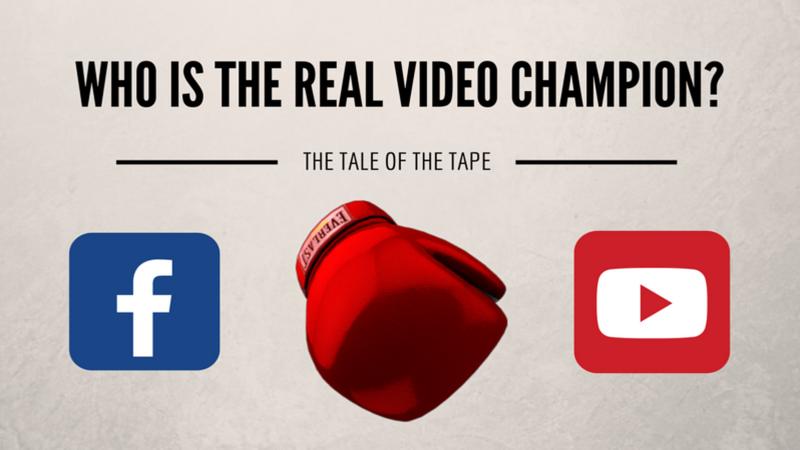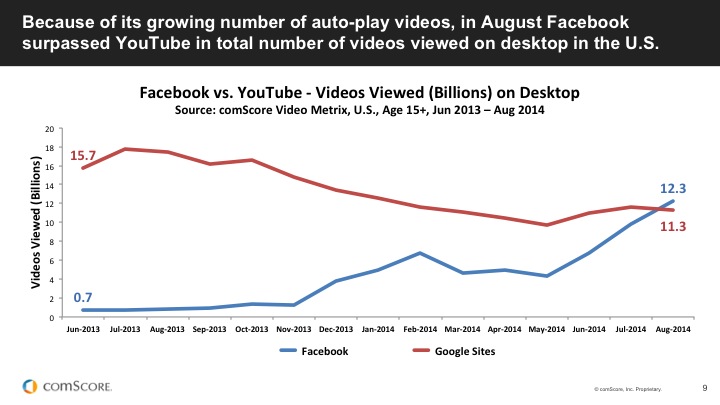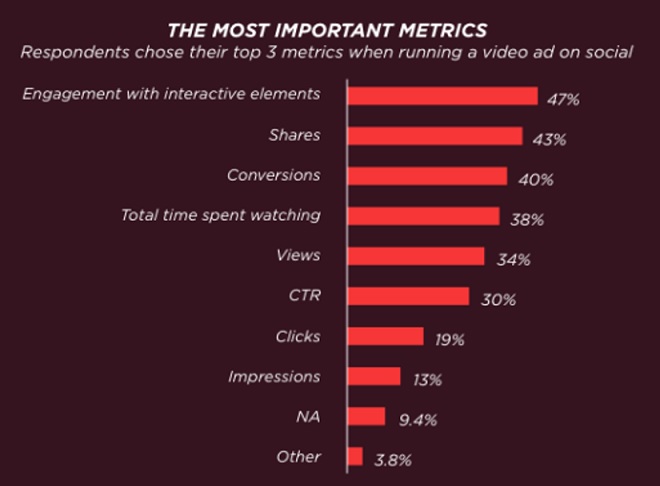

2016-01-07 12:00:00 AM | 6296 ![]() Print
Print ![]() PDF
PDF

In today's digital marketing world, video marketing has become so relevant in social media marketing that most social media giant sites are now jumping into the band wagon. Starting from the success rate Facebook is getting from the introduction, It didn’t take long for Instagram (now owned by Facebook) to launch a video product after the emergence and quick success of Vine (now owned by Twitter), even Twitter has launch their video upload in post and ads stream and not to forget Yahoo!.
But for a while now, their have been trending topics about Facebook video marketing overtaking YouTube video marketing as the contender for video on the web.
Facebook surpassed YouTube in total number of video views on desktop in the U.S. during August 2014 source by comScore. Most of this rising development is caused by Facebook Auto-play function as explained by Emeritus Gian Fulgoni on Beet.TV
“While there’ s reach advantage for auto-play, there’s an issue as to whether you’re getting good engagement. You’re getting good engagement from user-initiated (video on YouTube) by definition. If you figure how to create the video so it grabs people’s attention, you may have the benefits of high reach as well as engagement.”
Facebook has been pimping its video features and functionalities, with a new-and-improved Videos Tab, including Playlists, and a Featured Video module for pages, as well as the ability to embed Facebook videos across the web.

Marketers want as many people to watch their video ads as possible. But they only want to pay for the people who actually watch their videos. Facebook's autoplay video ads cover the former; YouTube's skippable TrueView spots offer the latter. So which is better for video marketing?
First Let's see How they both stack up in terms of 3 important rounds 1) Audience Targeting 2.) Advertising Cost and most importantly 3.) Engagement
Round 1
YouTube is the second largest search engine, following Google, with 3 billion monthly search queries and the beauty of it is that all search made on Youtube are Video related. So it be safer to say people going to Youtube already have a mind set to Watch Videos, so obviously you know you are targeting the right audience here, Unlike Facebook, were a user is most likely to watch a video base on social metrics like comments, likes or views. However, people are increasingly watching videos when they visit Facebook, which now averages 4 billion video views each day.
To watch a video ad on Facebook, a person has to be logged in to his or her account. That lets advertisers target their Facebook video ads specifically to a potential audience's age, gender, location and interests. "In terms of targeting, Facebook is still second to none in both segments and accuracy," Mr. Cronin said. YouTube offers similar targeting categories, but they don't match Facebook's specificity at scale, agency execs said. Some advertisers have compensated by contextually targeting their YouTube ads, aiming them at channel categories like fashion and do-it-yourself, said MEC's head of social for North America, Noah Mallin.
Round 2
I have written an elaborate post on YouTube advertising cost In addition to selling videos ads directly, Facebook and YouTube each offer self-serve tools, but work in differently. For both, an advertiser enters a budget and audience it's targeting. Facebook's tool offers a fixed cost per thousand impressions and estimated impressions per day. YouTube asks the brand to enter the maximum it would pay for a completed view. YouTube then estimates the average cost per view and how many views a day. Caveat: What a brand spends may be less than its budget, depending on how many impressions Facebook can serve (even if they aren't fully watched) and how many views YouTube can deliver. Facebook's self-serve tool also sells video ads through auctions. Overall, the two products don't differ greatly in price when factoring in variables like goals and valued metrics, according to Mr. Lange.
Price and cost are not the same thing."One huge pro of YouTube's skippable TrueView ads is that advertisers are only charged when the viewer views the entire ad, resulting in a more accurate cost per view," Mr. Cronin said. Facebook charges advertisers by the view and starts counting views after a video has played for three seconds. "With Facebook, especially with it being autoplay and three seconds considered a view (Facebook has now increased this to 10 seconds due to marketers complaints) it's important to make sure the reported views are translating," Mr. Lange said. Facebook reports details like how many views lasted for 50%, 75% and 100% of the video, so that advertisers can calculate the effective cost of an autoplay ad.
Round 3
The image below represent the areas that are most important for advertisers and majorly used as yardsticks to measure the success of their video marketing.
YouTube is inherently good for search engine optimization and driving views. However, views have become a less important indicator to marketers and advertisers in recent years. The Mixpo study revealed that, in a ranking of the most important metrics when running video ads on social, views placed fifth. What was more important? Engagement, shares, conversions, and total time spent watching. Facebook offers a larger opportunity for engagement and shares, which is why more and more advertisers are turning to the social network for their video campaigns.

In conclusion both audience targeting are not the same, is just similar to social media marketing on Facebook which is technically a way of direct marketing, in contrast to search engine marketing where people see the search engines as a yellow page to find things. With Facebook you need to sell your video to the viewer rather than the viewer deciding what to watch. You cannot get the same quality of leads. The prospects coming to you versus you show casing yourself to prospects, this is my professional view of how the two system weighs in terms of Audience Targeting and Lead Generation.
So who wins the video marketing bout? Both Facebook and YouTube are both different side of the same coin, which should be used as an integral part of your video marketing strategy efficacy.
Still not settled? Read the words from their site what both can offer your business Facebook video marketing and YouTube video marketing , so you can judge by yourself which best suit your type business.

I am a seo web analyst and have a love for anything online marketing. Have been able to perform researches using the built up internet marketing tool; seo web analyst as a case study and will be using the web marketing tool (platform).
How To Fix Cloudflare Error 522 Connection Timed Out
How To Optimize Cache Performance via HTACCESS Apache Server
How To Fix GA4 Showing Wrong Domain Traffic
How To Reactivate Google Adsense Account
How Do You Write Pitch Deck That Wins Investors
Effective Lead Magnet Funnel Examples For Businesses
How To Promote FMCG Products Using Digital Marketing
The Main Objectives Of SEO in Digital Marketing
How Artificial Intelligence Is Transforming Digital Marketing
Google CEO Sundar Pichai: Search will profoundly change in 2025